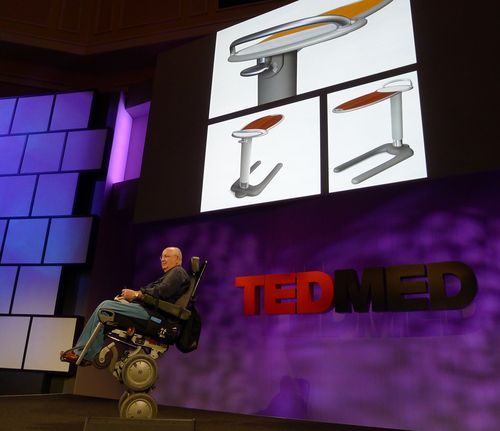Technologies are, by nature, biased. They are biased by the humans who create them. They are biased by the cultures in which they are produced. They are biased by the perceived needs of intended consumers and they are biased by agentic practices of consumption. A recent TEDMED talk (Why Hospital Rooms Don’t Work) by architect Michael Graves highlights the biased nature of technologies. Specifically, he demonstrates the embeddedness of privilege.
Michael Graves is a renowned architect. In 2003, Graves developed a rare (and still mysterious) illness that left him paralyzed. While fighting the illness and then undergoing rehabilitation, Graves spent a significant amount of time in hospitals. He found the facilities not only to be aesthetically displeasing, but impractical and sometimes downright inaccessible for a person with mobility impairments. He describes unreachable light switches and faucet handles, rooms so small that maneuverability is impossible, really ugly floral patterns, and an overall requirement that he, as a person in a wheelchair, ask for help with tasks that he should be able to complete independently. Summarizing these shortcomings he says:
They just made the most frustrating mistakes you could ever imagine and made your cure more difficult. Your room should make it easier for the doctors and the aides and the patient. But instead it does just the opposite.
These medical facilities, in short, were made by and for able-bodies. Or in other words, the architecture of these medical spaces were rooted in Able-bodied Privilege.
I argue that technologies can be biased in two broad ways: Explicitly and Seamlessly.
By explicit bias, I refer to technologies constructed with explicit political intention. Robert Moses, for example, an architect in the early 20th century, built New York bridges that were too low to be cleared by buses, denying access to poor minorities that relied on public transit. #OWS occupiers have constructed tent cities and (both variants of) the human microphone with the explicit political intention of disrupting ties between government and big business. And electric car manufacturers design technologies that reduce carbon emissions and promote the political goal of environmental stewardship. The biases in these technologies are explicit in that the creators worked with intention. They purposefully embedded the bias into the technology, and utilize the technology for a particular political goal. Seamless bias does not operate so clearly.

By seamless bias, I refer to technologically embodied privilege. By privilege, I do not necessarily mean disproportionate access to resources (although this is almost always the case), but to membership in the taken-for-granted unmarked social category: White Privilege; Male Privilege; Able-bodied Privilege. Bias, in this sense, is seamlessly built into the technology without conscious intentionality, as the producer and perceived consumer operate from the logical viewpoint of the unmarked human. Those who create IQ tests, for example, rely on a logic of whiteness not because the creators wish to penalize people of color, but because the logic of whiteness is, in U.S. society, the taken-for-granted unmarked form of logic. It is this latter form of bias that is highly difficult to pinpoint, and highly illuminating once discovered. It is difficult to pinpoint because it requires that we become conscious of that which eludes notice. It is illuminating because it shows us the assumptions under which we operate—it marks that which heretofore remained invisibly influential.
It is the seamless form of bias that was pinpointed by Michael Graves. Specifically, he highlighted the Able-bodied Privilege in which the architecture of hospital rooms is embedded. Able-bodied Privilege is rampant in U.S. society (and largely internationally). It is seen in city planning, as sidewalks often slant towards the road, making them efficient for draining water, but dangerous for a person navigating the terrain in a wheelchair. It is seen in everyday linguistic practices, as we conflate inadequacy with “lameness.” It is seen in internet technologies, as websites are designed first for seeing and hearing individuals, and sometimes adapted for those with visual and/or hearing impairments.
Able-bodied Privilege is perhaps epitomized by the architecture of medical facilities. These spaces are created for the rehabilitation of those with physical impairments, and yet, as Graves points out, are designed according to able-bodied logic.
Graves is working to rectify the bias by designing hospital spaces that enable (rather than constrain) those with mobility impairments. In doing so, he requires his staff to spend time in a wheelchair. He takes them out of their privileged positions and gives them a glimpse (be it brief and imperfect) of the view from which the consumers of this technology will operate. This further highlights the need for diversity in all fields of technology design and production. To get outside of privileged logic we need the perspectives of those looking in, as well as the inclusion of voices from those who privileged logic leaves out.


Comments 9
Doug Hill — December 20, 2011
JD --
Thanks for this excellent essay. The fact that values are built into our technologies is a key reason why the machine is more than just the machine. One form of privilege that seems especially pervasive: money privilege.
Question: You mention that some technologies embody male privilege, and I don't doubt that's true. Are there also technologies that embody female privilege?
DH
Doug Hill — December 20, 2011
No, no specific suggestions...just asking. I do think that virtually every group has privileges in given situations, and it's possible that a claim that there is no such thing as privilege for a given group may in fact be a way of claiming privilege. This is by no means intended to deny the dominance of male hierarchy, etc., as manifested in technologies and otherwise.
Progress versus ableism: The case of Ekso » Cyborgology — January 17, 2012
[...] spaces do not facilitate such free use of a wheelchair. I wrote about this more extensively in an earlier post. With this in mind, I will now elaborate on is the difference between disability and physical [...]